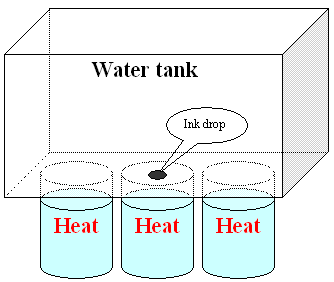On this page, you will learn thermal energy transfers through fluid motion by a mechanism called convection. In air, convection transfers heat much faster than conduction. There are two types of convection: natural convection and forced convection.
Convection
Learning goal
❶ Natural convection between a warm plate and a cold plate
|
You may have seen a science experiment that shows convection with ink. The experiment uses cups of hot water
to warm up a small tank of room temperature water. An ink drop is added to the bottom of the tank. The warm
water rises and carries the ink, thus allowing the process to be seen.
(See this YouTube video.)
The simulation on the right below shows this process on the computer. Unlike the real experiment, we do not have to use ink and we can show the convective flow everywhere in the liquid—not just the portion dyed by ink. Follow these steps: 1. Click "Run" to start it. Observe what happens. Select "Graph On" to bring up the temperature graph. Monitor how the temperature recorded by the upper thermometer rises. 2. Click "Reset", and then click "Off" to turn off convection (something you can't really do in the real experiment). Repeat the steps in 1). 3. Click "On" to activate the convection mechanism again. Select "Low" to reduce the bottom temperature, and repeat the steps in 1). 4. Click "Reset". Move the heating plate (the red slab) to the middle of the container (you can do that by dragging it or clicking on it and then using the Up/Down arrow key to nudge it). Compare the heating in the upper part and the lower part. Can you explain what you observe? 5. Click "Reset". Change the surface area of the heating plate that is exposed to the fluid using the "Surface area" options. Observe the heat transfer to the upper plate. |
|||
|
❷ Accelerating heat transfer through forced convection
| In the following simulation, there are two compartments that are separate from each other. Two identical objects with the same initial temperature are placed in each compartment. In the upper compartment, there is a fan that is blowing to the right. In the lower one, there is no fan. Start the simulation and compare the speed that the objects are cooled down. Click the "On" button to bring up the temperature graph for a better comparison. | |||
|
Summary
The amount of thermal energy ΔQ transferred from a surface area A in a time period Δt through natural convection of fluid is approximately determined by the following equation:
ΔQ/Δt=-hA(T-T∞)
where T is the temperature of the surface, T∞ is the temperature of the environment, and h is the convective heat transfer coefficient of the fluid. This equation is sometimes called Newton's Law of Cooling. The heat transfer through forced convection is more complicated as it depends also on the fluid speed as a result of the external force.
Question: (Click the link below to answer)
Explain Newton's Law of Cooling based on the above simulations.


